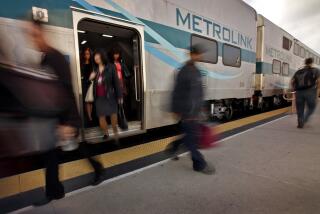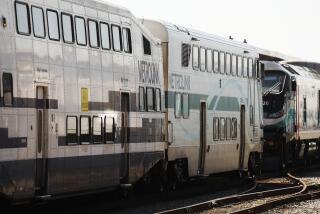Experts say sequence of signals may have contributed to Metrolink crash
- Share via
The position of trackside warning signals near the Chatsworth Metrolink station could have increased distractions for the engineer involved in September’s deadly collision with a freight train, according to experts who cite the causes of a similar crash a decade ago.
Several hundred yards and a few seconds before arriving at the Chatsworth station, Metrolink engineer Robert M. Sanchez passed a critical solid yellow signal that should have warned him to stop at the next light about a mile after the depot, according to federal safety investigators.
Placing the yellow light before a station, experts say, creates an opportunity for distractions for engineers -- who must bring the train to a halt, communicate with conductors and focus on passengers getting on or off. This is especially critical in places like the Chatsworth station, where the signal after the depot is near a point where the main line merges with another track.
“It’s certainly not unreasonable to consider that he may have totally forgotten about the yellow,” said Barry M. Sweedler, a former investigator with the National Transportation Safety Board who helped probe a Maryland accident a decade ago with similar circumstances. “If you interrupt the sequence [and] passengers get on, a couple of minutes go by. . . . Think of the distractions.”
Leaving the station, Sanchez accelerated to 54 mph, received and sent text messages and sailed through the stop light, slamming into a Union Pacific freight train, investigators say. The engineer and 24 passengers died in the accident and 135 were injured.
Signal locations have been determined largely by factors such as curves, double track switches and the stopping and movement requirements of longer, heavier freight carriers that share track with Metrolink trains, according to the commuter service.
But ideally, key warning signals -- or, at the very least, reminder signs -- should be positioned right after the depot at stations such as Chatsworth, according to the experts.
Teams of NTSB investigators are examining signal issues and human factors that could have contributed to the Sept. 12 collision. Signal positions and any potential to increase human error will probably figure into the inquiry, which is expected to take months to complete, Sweedler said.
Metrolink officials have declined to discuss the crash, saying they are prohibited from talking because of the ongoing federal investigation.
But the agency does not agree that a station stop between signals creates potential distractions, said spokesman Francisco Oaxaca. Keeping signals in mind at all times is “a fundamental part of a passenger engineer’s job,” he said.
Depending on signal settings, any of Metrolink’s 55 stations could be between a solid yellow light and a red stop light on the current system, Oaxaca said.
As part of a sweeping safety initiative in the wake of the Chatsworth crash, the agency is reexamining signal locations. The criteria for possible changes are being developed, but “obviously visibility and human factors are going to be on that list,” Oaxaca said.
So-called approach lights -- yellow warnings of a stop signal ahead -- should never be placed before stations such as Chatsworth, said Ron Kaminkow, a veteran engineer and official with Railroad Workers United, a coalition of eight rail employee unions.
“It doesn’t make sense. Logic would dictate that you want to set up a signal system that would allow for as little human error as possible,” he said.
“There’s all sorts of things that can happen at station stops,” he added. “Whatever it might be, a pause in the action gives opportunity for distraction.”
A 1996 head-on collision in Maryland was blamed largely on distractions caused by a station stop that a commuter train made after it passed an approach signal, records show. Federal investigators concluded that the engineer forgot about the warning, sped away from the station and then was unable to stop at a junction where an approaching Amtrak train had the right of way.
Eight passengers and all three crew members on the commuter train died in the fiery collision.
“The physical and mental tasks associated with stopping the train at [the] station provided the primary source of interference,” the NTSB concluded in its investigation of the crash. These “attention-demanding tasks” included reducing the throttle, applying the brakes and positioning the train properly in the station, investigators found.
After that accident, the rail company that operated the commuter train and signal system, CSX Transportation, added reminder signs before and at the station where the crash occurred.
The signs are safety enhancements because an engineer’s “attention might be diverted picking up passengers,” said CSX spokesman Gary Sease.
Metrolink’s signal system complies with federal regulations, but no extra reminder signage has been added, said Steve Lantz, the agency’s communications director.
Oaxaca noted that other safety procedures for passenger trains, including speed restrictions after station stops and signal-announcing requirements for crew members, were added to federal operating rules after the Maryland crash. But both of those regulations appear to have been violated in the Chatsworth disaster, according to preliminary findings by the NTSB.
The overriding distraction in Chatsworth may have been the text messages that federal investigators say Sanchez sent and received that day from his cellphone. The engineer did so despite a Metrolink ban on use of personal electronic devices by crews operating trains.
In a little over two minutes, records and interviews indicate, Sanchez received a message shortly after leaving the station and sent a final message seconds before the crash, just after passing the red light.
The Metrolink conductor, who survived, and three witnesses have told investigators that the final light before the trains collided was green. But the NTSB says all of its testing indicates that the light was red and that it was visible, although a recent Times report disclosed that it was not as bright as other lights on the same signal post and that one investigator had commented three days after the crash, “Can’t hardly see the red.”
Safety experts note that research shows human error is reduced when an uninterrupted sequence of warnings or events precedes a crucial task -- such as stopping a train at a red light to let another train pass.
The normal sequence of railroad signal lights is intended to alert and remind the engineer and crew of the potential danger ahead, said USC professor Najmedin Meshkati, who studies human behavior related to safety.
A station stop between signals increases chances of mistakes, he said.
“It really puts into question the design of that signal system,” he said. Like the rail workers coalition, he questioned why the solid yellow signal -- or at a minimum a reminder light or sign -- was not placed immediately after the station.
“These things are designed in a very haphazard way,” he said.
Meshkati, who has followed the Metrolink investigation, has called for the agency to conduct a thorough review of the system’s operations with an emphasis on incorporating routines and redundancies that can compensate for human failings.
“Safety warnings in the proper sequence are the issue,” he said. “You should keep all the variables as controlled as you can.”
Indeed, records show the NTSB concluded that the Maryland accident might have been avoided had officials conducted a comprehensive review of the signal system, including an analysis of “human factors” that could affect its safety.
After a two-month review, a panel of experts recently called on Metrolink to increase its focus on potential safety hazards across the five-county commuter system and to step up oversight of train crew behavior.
The agency could start with the signal Sanchez passed just before the Chatsworth station, said Kaminkow of the rail workers coalition. “You need to get rid of it and replace it with one” on the other side of the station.
More to Read
Sign up for Essential California
The most important California stories and recommendations in your inbox every morning.
You may occasionally receive promotional content from the Los Angeles Times.











